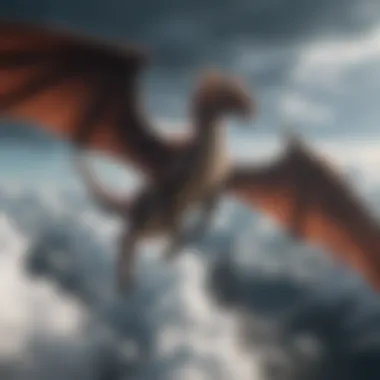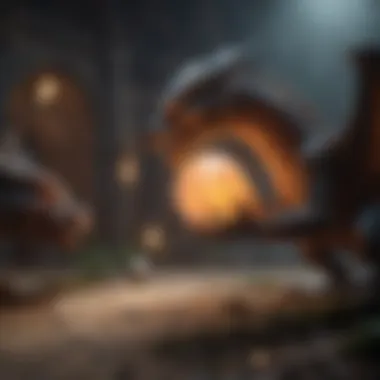Unveiling the Enigmatic World of Dragons Playing and Their Playful Behaviors


Character Dissections
In delving into the captivating world of dragons and their playful behaviors, it is crucial to examine the intricacies of their character traits. Dragons in mythology are often portrayed as majestic and powerful creatures, breathing fire and soaring through the skies with grace. However, their playful side is less explored, offering a nuanced understanding of these mythical beings. Through a detailed analysis of key characters in dragon lore, such as Smaug from 'The Hobbit' or Drogon from 'Game of Thrones,' we can unravel their playful tendencies and how these traits intersect with their majestic allure. Understanding the character development of dragons throughout various literary works and mythologies provides insights into the diverse representations of their playful behaviors and the impact on the overarching narrative, adding depth to their mystical allure.
Episode Breakdowns
While dragons playing might seem like a whimsical concept, it has deeper implications embedded within episodes of fantasy series like 'Game of Thrones.' By recapping significant events where dragons engage in playful antics or interactions, we can unravel themes and symbolism associated with their behaviors. These key moments offer glimpses into the emotional and psychological aspects of dragons, shedding light on their intelligence and social dynamics. Exploring these sequences allows us to appreciate the intricacies of dragon playfulness beyond surface entertainment, highlighting how these moments contribute to character development and thematic richness within the series.
Lore Explorations
To truly grasp the phenomenon of dragons playing, it is essential to dive into the rich lore and history surrounding these mythical creatures. From ancient legends to contemporary adaptations, dragons permeate global folklore with their intriguing presence. Delving into the cultural and mythical aspects of dragons unlocks hidden details and connections that enhance our understanding of their playful nature. By exploring the intricate web of dragon lore, we can uncover underlying motifs and symbolisms that shape these creatures' playful behaviors, creating a tapestry of mythical significance that resonates across different cultures and storytelling traditions.
Fan Theories
As with any beloved fictional universe, fan theories abound regarding dragons and their playful inclinations. These speculative narratives offer fresh perspectives on dragon behavior, enticing fans to delve deeper into the whimsical world of mythical creatures. By compiling popular and intriguing fan theories surrounding dragons playing, we can tap into the collective imagination of the audience, sparking debates and discussions on possible interpretations. Evaluating these theories based on evidence from various sources, including literature, television, and folklore, allows us to speculate on future plot developments and potential revelations, keeping the excitement alive for fans of fantastical tales.
Introduction to Dragons
Being an ancient and enigmatic part of folklore and mythology, dragons hold a prominent place in various cultures worldwide. This section serves as a gateway into the enigmatic world of these majestic beings, shedding light on their symbolic importance and mythical features that have captivated human imagination for centuries. Exploring the origins of dragons in mythology allows us to delve deep into the intricate tapestry of their symbolism across different cultures, unveiling the layers of meaning attached to these mythical creatures. By understanding the evolution of dragons in popular culture, we can witness the dynamic adaptations and reinterpretations that have kept these creatures relevant throughout generations.
Origins of Dragons in Mythology
Their Symbolism in Different Cultures
Dragons represent a multitude of symbols in diverse cultures, ranging from wisdom and strength to chaos and destruction. Their portrayal often mirrors the values and beliefs of the society interpreting them, making them versatile symbols across civilizations. The unique charm of dragon symbolism lies in its ability to transcend linguistic and cultural barriers, resonating with audiences worldwide through its universal themes of power and mystery.
Mythical Features and Abilities
The depiction of dragons in various mythologies showcases an array of fantastical traits and capabilities, from breathing fire to shape-shifting abilities. These mythical features not only add layers of intrigue to dragon lore but also reflect tangible aspects of human desires and fears. Exploring these diverse features grants us insight into the imaginative depths of ancient storytellers and the enduring appeal of dragon mythology.


Evolution of Dragons in Pop Culture
Depictions in Literature
In literature, dragons often serve as formidable foes or wise mentors, embodying a mix of awe and fear in the minds of readers. Their adaptability in narratives allows authors to craft compelling stories filled with conflict and growth, making them essential characters in the fantasy genre. Through a lens of literary analysis, we can unravel the rich tapestry of dragon lore woven into classic and contemporary works.
Portrayals in Movies and TV Shows
The visual medium of film and television has brought dragons to life in spectacular ways, captivating audiences with their grandeur and mystique. From fierce antagonists to loyal companions, dragons in movies and TV shows evoke a wide range of emotions and spark the imagination of viewers. Analyzing their portrayals on screen offers a glimpse into the evolving trends of dragon representation and the impact of visual storytelling on shaping popular perceptions of these mythical beings.
Understanding Dragon Behavior
Dragons, enigmatic beings of myth and legend, exhibit a complex range of behaviors that intrigue and captivate our imaginations. Understanding their behavior is crucial in unveiling the mysteries surrounding these magnificent creatures. By delving into the specific elements of dragon behavior, such as their social interactions, emotional intelligence, and playful tendencies, we can unravel the intricate tapestry of their existence. Each aspect offers a unique perspective into the inner workings of dragons, shedding light on their motivations and responses to various stimuli. This article seeks to shed light on the significance of analyzing dragon behavior as a key step in deciphering the enigmatic nature of these legendary beings.
Social Interactions Among Dragons
In the intricate tapestry of dragon society, the hierarchy within their communities plays a pivotal role in maintaining order and structure. The hierarchy dictates the power dynamics among dragons, with dominant individuals exerting control over their subordinates. Understanding the intricacies of this hierarchy is essential for grasping the subtle nuances of dragon behavior. By exploring the key characteristics of hierarchy within dragon communities, we can discern how relationships are forged and maintained, ultimately shaping the collective behavior of dragon populations. This examination provides valuable insights into the social dynamics that govern dragon interactions.
Hierarchy within Dragon Communities
The hierarchical structure within dragon communities showcases a fascinating interplay of power and dominance. Dominant dragons assert their authority through displays of strength and prowess, often leading to intricate social hierarchies within their ranks. This pecking order establishes clear lines of authority and influence, influencing everything from hunting patterns to mating rituals. While this system promotes order and stability, it can also breed conflicts and rivalries among dragons vying for position within the hierarchy. Understanding the complexities of this social structure sheds light on the motivations driving dragon behavior and the intricacies of their social fabric.
Communication Methods
Communication lies at the heart of social interactions among dragons, serving as the bedrock of their interconnections. Dragons employ various methods to convey messages, ranging from vocalizations and gestures to more subtle forms of non-verbal communication. Each communication method bears unique advantages and disadvantages, influencing how information is conveyed and received within dragon communities. By delving into the intricacies of dragon communication, we gain valuable insights into the nuances of their social dynamics and the bonds that bind these majestic creatures together.
Emotional Intelligence of Dragons
Apart from their social interactions, dragons exhibit a remarkable level of emotional intelligence, enabling them to form deep bonds with other creatures and respond sensitively to environmental stimuli. This emotional depth adds a layer of complexity to their personalities, shaping how they navigate the world around them. By exploring the facets of dragon emotional intelligence, we can unravel the enigmatic nature of their interactions and glean insights into their motivations and responses.
Empathy and Bonds with Other Creatures


Dragons' capacity for empathy allows them to form profound bonds with other creatures, transcending species boundaries. This ability to empathize fosters connections based on mutual understanding and companionship, enriching their lives with diverse relationships. By examining the role of empathy in dragon behavior, we uncover the emotional richness that underpins their interactions and the depth of their emotional landscapes.
Responses to Environmental Stimuli
In their natural habitat, dragons respond to a myriad of environmental stimuli that shape their behaviors and decision-making processes. From subtle shifts in temperature to changes in prey abundance, dragons exhibit a keen sensitivity to their surroundings. This responsiveness to environmental cues underscores their adaptability and survival instincts, highlighting the intricate balance between instinctual responses and learned behaviors. By elucidating the ways in which dragons react to environmental stimuli, we gain valuable insights into their cognitive processes and the adaptive strategies they employ to thrive in diverse ecosystems.
Dragons at Play
Exploring the poignant theme of Dragons at Play is pivotal within this article, as it unravels the intricate nature of these mythical beings' recreational activities. Understanding how dragons engage in different forms of play offers a unique lens into their behavior and psyche. By delving into this subject, we can unearth valuable insights into their social dynamics and cognitive development. The section on Dragons at Play serves as a foundation for comprehending the broader spectrum of dragon behaviors discussed throughout this article.
Types of Playful Behavior
Aerial Games and Acrobatics
Discussing the phenomenon of Aerial Games and Acrobatics is imperative in elucidating the physical prowess and graceful movements displayed by dragons in their play. To delve into the skies and wield such agility speaks volumes about the athleticism inherent in these creatures. The intricacy of aerial maneuvers not only showcases their dexterity but also highlights the sheer joy and freedom dragons experience during such activities. Aerial Games and Acrobatics provide a platform for dragons to express themselves creatively while honing their physical skills, making it a cornerstone in the exploration of dragon play.
Interactive Games with Other Dragons
Examining the aspect of Interactive Games with Other Dragons brings to light the social intricacies and bonding experiences within dragon communities. Engaging in playful interactions fosters camaraderie and strengthens the communal fabric among these mystical beings. The collaborative nature of interactive games cultivates empathy, communication skills, and mutual understanding, enhancing the cohesion among dragons. By partaking in such games, dragons not only entertain themselves but also forge lasting relationships, underlining the significance of social play in their existence.
Learning Through Play
Skill Development in Young Dragons
Unveiling the realm of Skill Development in Young Dragons sheds light on the formative stages of dragon growth and acquisition of abilities. Through play, young dragons refine essential skills such as hunting, flying, and elemental control. The structured play sessions not only enhance their physical aptitude but also foster cognitive development and adaptability. The integration of play into skill-building exercises lays a sturdy foundation for their future roles and responsibilities within the dragon hierarchy.
Strategic Thinking and Problem-Solving
Exploring the domain of Strategic Thinking and Problem-Solving underscores the significance of mental stimulation and adaptive planning in dragon play. By engaging in challenges that require strategic decisions and problem-solving skills, dragons enhance their cognitive faculties and decision-making processes. The ability to strategize and overcome obstacles through play not only sharpens their intellect but also prepares them for real-world scenarios they may encounter. Strategic Thinking and Problem-Solving through play serve as essential cornerstones in nurturing dragons' analytical and tactical acumen.
Implications of Dragons Playing


In delving deeper into the realm of dragons playing, one uncovers a myriad of implications that go beyond mere amusement. The playful demeanor of dragons holds significant relevance in understanding their social structures and cognitive abilities. By observing dragons engaging in various playful behaviors, one can gain valuable insights into their communication methods, problem-solving skills, and even emotional intelligence. This section seeks to illuminate the multifaceted nature of dragons playing and its implications on their overall development and interactions within their communities.
Cultural Significance of Playful Dragons
Mythical Representations in Folklore
Exploring the mythical representations of playful dragons in folklore unveils a tapestry of symbolic meanings and cultural interpretations. Dragons have long been revered as symbols of power, wisdom, and protection in various mythologies across the globe. The depiction of dragons engaging in play highlights their dynamic nature and showcases them not just as fearsome beasts but also as creatures capable of joy and camaraderie. This portrayal adds depth to the narrative of dragons, emphasizing their role as not just mythical beings but as relatable entities with emotions and thought processes.
Contemporary Interpretations
In contemporary times, the interpretation of playful dragons has evolved to reflect modern societal values and beliefs. From being depicted as guardians of treasures to companions in epic adventures, playful dragons in today's context symbolize more than just mythical creatures. They embody themes of friendship, loyalty, and resilience, resonating with the audience on a more personal level. The contemporary take on dragons at play introduces a fresh perspective on age-old legends, breathing new life into their portrayal and fostering connections with audiences of diverse backgrounds.
Psychological Insights from Dragon Play
Impact on Dragon Development
Analyzing the impact of play on dragon development uncovers essential aspects of their growth and maturation. Playful activities not only serve as outlets for physical exertion but also play a crucial role in honing their skills and instincts. By engaging in playful behaviors, dragons enhance their coordination, agility, and cognitive abilities, laying the foundation for successful interactions within their environment. This section aims to shed light on how play shapes the developmental path of dragons, influencing their behaviors and responses as they navigate their existence.
Comparative Studies with Play in Other Species
Comparative studies highlighting dragon play in relation to other species offer intriguing insights into cross-species behavioral patterns and evolutionary dynamics. By examining how dragons engage in play compared to creatures like griffins, wyverns, and other mythological beings, researchers can draw parallels and distinctions that enrich our understanding of play behavior in mythological contexts. This comparative approach paves the way for interdisciplinary exploration, opening avenues for collaborative research and innovative discoveries in the field of mythical creature studies.
Conclusion
Dragons Playing is a topic that delves deep into the playful behaviors of these mythical creatures, uncovering insights into their social interactions and emotional intelligence. Throughout this article, we have explored the different types of play exhibited by dragons, from aerial games to strategic thinking. Understanding dragons at play not only enriches our knowledge of their behavior but also provides a glimpse into the cultural and psychological significance of their playful nature. By studying how dragons engage in play, we can gain a deeper understanding of their world and the impact of playful activities on their development and interactions. The topic of Dragons Playing is not merely about entertainment but serves as a doorway to a deeper comprehension of these majestic beings.
Revelations and Speculations
The Enigmatic Nature of Dragons
The enigmatic nature of dragons adds a layer of mystery to our exploration of these mythical creatures. Their ability to inspire awe and fear simultaneously showcases the complexity of dragon behavior. Delving into the enigmatic aspects of dragons reveals a world filled with contradictions and hidden depths, making them a compelling subject of study. The elusive nature of dragons challenges researchers and enthusiasts alike to unravel the secrets that lie within these fascinating beings.
Future Research Directions
Considering the future research directions in the study of dragons playing opens up avenues for continued exploration and discovery. Identifying key areas for further investigation can lead to enhanced understanding of dragon behavior and its implications. By focusing on future research directions, we can anticipate new insights and breakthroughs in this field, paving the way for a more comprehensive appreciation of dragons and their playful activities. Exploring new research opportunities holds the promise of unveiling more about the intricate world of dragons playing and the lessons it offers for both scholars and enthusiasts.

